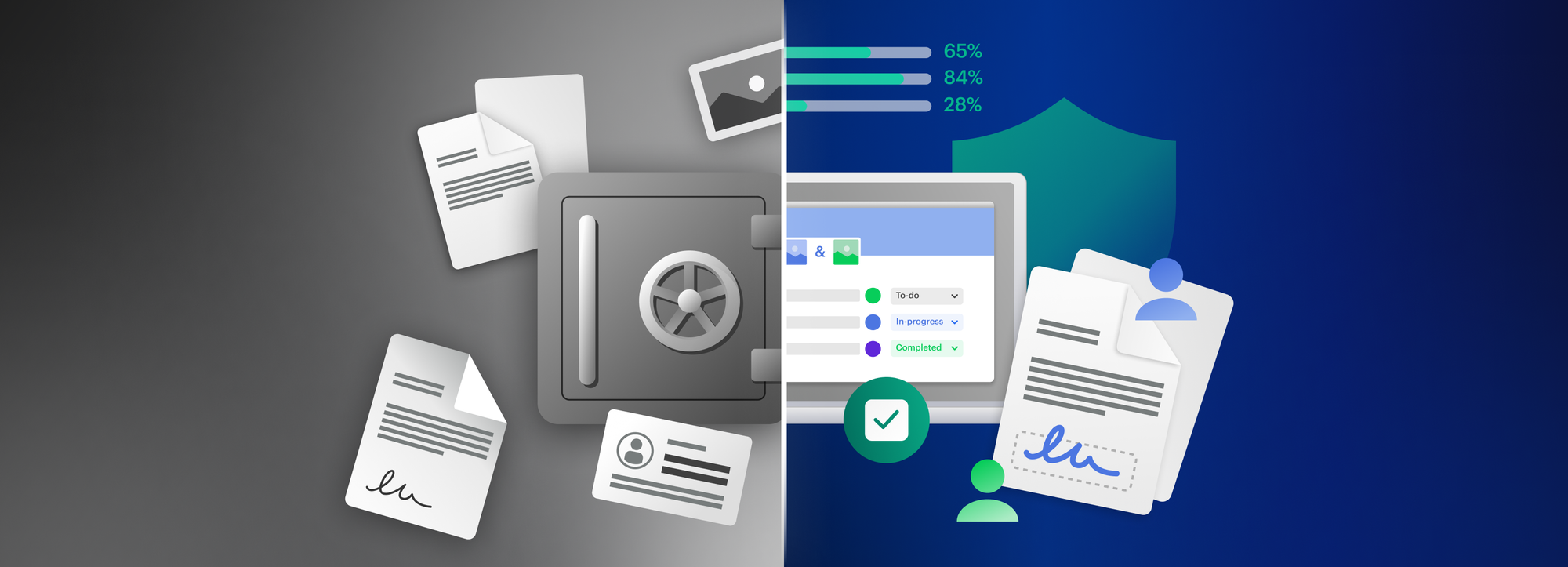Your guide to understanding simple e-signatures and qualified e-signatures

The digital era has transformed how companies handle documents and conduct business. One crucial aspect of this change is the adoption of electronic signatures, which are more convenient, more efficient, and more secure than their traditional paper-based counterparts.
In this blog post, we’ll explore two types of electronic signatures: simple e-signatures and qualified e-signatures.
We’ll dive into the benefits, legal grounding, and main uses of digital signatures, as well as some key differences between different them.
We’ll also explain how your company can ensure its electronic signatures are legitimate and how Tresorit can further protect the confidentiality of signed documents.
What are the benefits of simple e-signatures and qualified e-signatures?
Both simple e-signatures and qualified e-signatures offer numerous advantages over their traditional ink-and-paper counterparts. They include:
- Time and cost savings: electronic signatures eliminate the need for the printing, mailing, and storing of physical documents, resulting in significant time and cost savings for businesses.
- Enhanced efficiency: electronic signatures streamline the document-signing process, enabling faster turnaround times and improved workflow efficiency.
- Convenience and accessibility: with electronic signatures, signatories can sign documents anytime, anywhere, with their computer, tablet, or smartphone.
- Enhanced security: electronic signatures can offer a host of advanced security features such as encryption and authentication measures, ensuring the integrity and authenticity of signed documents.
- Legally binding: In the majority of the cases, both simple eSignatures and qualified eSignatures can be considered as legally binding in accordance with the most signature laws. However, simple eSignatures provide the least legal guarantees and its validity can be questioned in court.
As opposed to this, qualified electronic signatures ensure the highest level of legal validity, deemed to be the legal equivalent of handwritten signatures.
Simple eSignatures
A simple e-signature, also known as a basic electronic signature, is a digital representation of a handwritten signature. It can be as simple as typing a name, drawing a signature using a touch screen, or using an image of a signature.
Simple e-signatures are widely accepted and legally binding in most jurisdictions.
They are governed by various laws and regulations, including the United States Electronic Signatures in Global and National Commerce Act (ESIGN Act) and the European Union eIDAS Regulation. These legal frameworks state that simple eSignatures shouldn’t be denied legal effect just because they are electronic.
What are the main uses for simple electronic signatures?
Simple e-signatures are commonly used for a wide range of everyday business transactions, including:
- Contract signing: simple e-signatures facilitate the signing of contracts, agreements, and other legally binding documents.
- Consent forms: simple e-signatures are utilized to obtain consent for various purposes, such as medical treatments, data processing, and event participation.
- HR documentation: simple e-signatures streamline the signing of employment contracts, confidentiality agreements, and other HR-related documents.
- Sales and procurement: simple e-signatures enable sales contracts, purchase orders, and invoices to be signed digitally, enhancing efficiency in the sales and procurement process.
Qualified e-signatures
A qualified electronic signature (QES), is the most secure and widely accepted form of electronic signature. It involves a rigorous identity verification process and utilizes advanced cryptographic techniques to ensure the highest level of security and authenticity. Qualified e-signatures are governed by the eIDAS Regulation in the European Union, which sets forth stringent requirements for their creation, verification, and legal value. These signatures are considered highly reliable and hold the same legal value as traditional handwritten signatures.
What are the main uses for qualified electronic signatures?
Qualified e-signatures are typically used in situations that require a higher level of trust, security, and compliance, such as:
- Highly regulated Industries: qualified e-signatures are prevalent in industries with strict regulatory requirements, such as finance, healthcare, and government sectors.
- Legal documents: qualified e-signatures are commonly used for signing deeds, wills, court documents, and other legally-binding agreements that require a higher level of authenticity and trust.
- Cross-border transactions: qualified e-signatures have cross-border recognition, making them suitable for international transactions that demand a higher level of legal certainty.
How are simple e-signatures different from qualified e-signatures?
There are a few key differences between simple e-signatures and qualified e-signatures:
- Level of assurance: simple e-signatures provide a lower level of assurance and do not require specific certification or identity validation.
- Specific use cases: simple e-signatures are suitable for most everyday business transactions. However, they may not be appropriate for highly regulated industries or transactions that require a higher level of trust and security.
- Limited legal admissibility: While simple eSignatures are, in general, admissible in court, their legal standing may be subject to scrutiny in certain situations.
How Tresorit can help your business use electronic signatures securely and legitimately
Electronic signatures can play a crucial role for businesses that want to enhance document security and streamline their operations — and that’s where Tresorit comes into play.
Tresorit is a trusted secure file-sharing and collaboration platform that offers industry-leading end-to-end encryption and advanced security features to safeguard sensitive documents.
Tresorit allows businesses to securely store, share, and sign documents, while ensuring that organizations remain in full control over their data. The platform's robust encryption protocols and zero-knowledge architecture ensure that no one — not even Tresorit itself — can access documents without the correct authorization, preserving the integrity and confidentiality of your most important data.
With Tresorit, companies can combine the benefits of electronic signatures with the highest levels of data protection. We offer tools that can add watermarks to your documents, track exactly which users have accessed certain files, and verify the identity of your recipient.
Electronic signatures, whether simple or qualified, are an exciting way to move your business into the 21st century, offering significant benefits in terms of efficiency and cost. But streamlining your business processes should never mean sacrificing what matters most — the security of your data and customer trust. But by leveraging the right tools, companies can strengthen the integrity and security of electronically signed documents, providing organizations with the peace of mind and confidence they need to truly benefit from the digital age.






